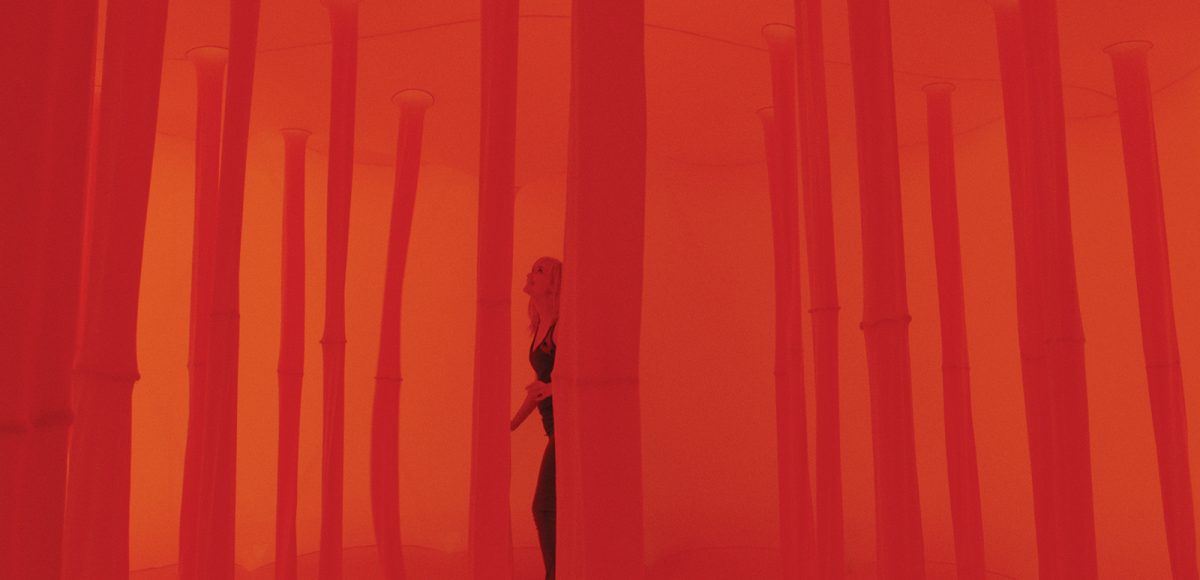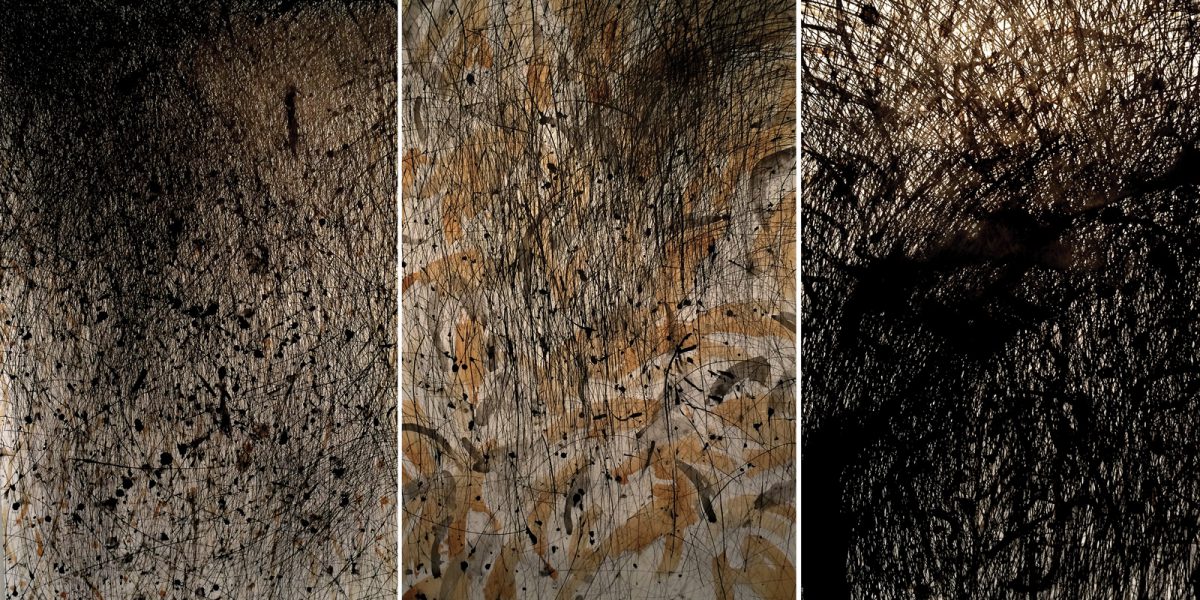In the summer of 2013, a train traveled 4,000 miles from New York City to San Francisco. It was a kinetic light sculpture, decked out in LED lights that responded to motion and sound. On board was an eclectic mix of artists, musicians and writers who stayed with the train for various legs of its 24-day journey. They shot laser shows on the tracks, filmed the train as it burst through paper barricades, had spontaneous jam sessions, and talked.
Whenever the train stopped at stations, things happened—art, DJ shows, performances by singer-songwriters like Beck and Patti Smith, marching bands, scream rockers and sign twirlers, a singing auctioneer and a percussive whip artist. Everything was filmed.
The driving force behind Station to Station was award-winning Venice-based multimedia artist Doug Aitken, who has turned the experience into a movie of the same name. The film is made up of 62 one-minute films including bursts of music and art, thoughtfulness and randomness. Famous talking heads include Jackson Browne and Ed Ruscha, as well as the more anonymous—a random hitchhiker and a folk artist in the middle of the Mojave Desert.
We spoke to Doug Aitken in July while he was in London for a month-long Station to Station ‘living exhibition’ at the Barbican Centre.
Fabrik: What inspired Station to Station?
Doug Aitken: I wanted to create a project that was nomadic. I was attracted to having a situation that was constantly changing. If you lose the sense of place, the comfort of where you are, and that’s taken out of the equation, you have a totally different condition creatively.
What is it about the American landscape that lent itself to the project?
Most people who live in cities are conditioned to this idea that you have New York, Los Angeles, San Francisco, Boston, Chicago, these beacons of light, and a lot of what happens in between is forgotten or ignored.
The project was really stimulating for that reason. You’re moving through the plains, or you’re moving through the desert, or you’re moving through some kind of repetitious farmland. It talks to the idea of a larger sense of landscape, a larger sense of place. We have an idea of a society that’s turned on, that’s moving fast, that’s stimulating. I wanted to find a balance between that and places that are more about negative space and emptiness.
With the stream of short segments, there’s a sense that you’re dipping into many experiences, which is very indulgent, but also that you don’t have to commit to any one. Why did you choose to make the film like this?
I wanted the project to show that this is a very kaleidoscopic landscape, with many, many voices. For myself, it was an attempt to tell a larger, wider story, a broader landscape than a conventional narrative.
We spent about 14 months editing, and I found it was more like we were creating music than film, and I found these rhythms to the minutes. Sometimes there’d be something that was harsh and abrupt and violent, and another time you would have two or three that merged together in a really seamless, elegant way. I was attracted to that because it felt unique to me, and it felt like, when I watched it, I was always engaged in the present.
In the movie, Beck describes time as compressed when you travel, so that a week seems like a month. He also says travel makes unexpected things happen. Was that true for you?
When you’re outside of the location that you’re most familiar with, when you’re in motion, you fall into situations that you feel not so safe and not so secure with. You’re vulnerable, and also your perception is open to taking in different kinds of experiences.
Station to Station isn’t a tour. It’s constantly changing. There is almost no one who is on the entire journey. The specific purpose for that was to have different experiences circulating and have something that was kind of living – a living organism, in a way.
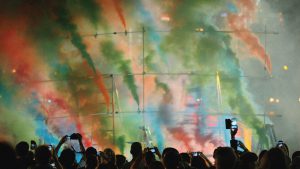 Olaf Breuning’s Smokebomb Artwork in Station to Station
Olaf Breuning’s Smokebomb Artwork in Station to Station Aaron Koblin and Ben Tricklebank’s Artwork “Light Echoes” in Station to Station
Aaron Koblin and Ben Tricklebank’s Artwork “Light Echoes” in Station to Station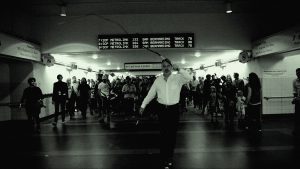 A Whipper Performs at the Los Angeles Happening in Station to Station
A Whipper Performs at the Los Angeles Happening in Station to Station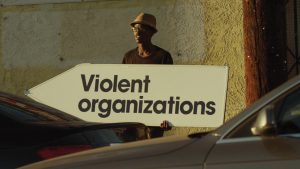 Sign Spinners Perform an Artwork by Doug Aitken in Station to Station
Sign Spinners Perform an Artwork by Doug Aitken in Station to Station The Interior of Urs Fischer’s Yurt Artwork in Station to Station
The Interior of Urs Fischer’s Yurt Artwork in Station to Station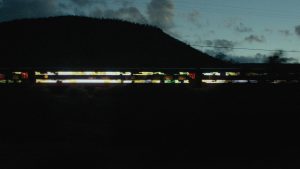 Doug Aitken’s LED Train Artwork in Station to Station
Doug Aitken’s LED Train Artwork in Station to Station Thurston Moore Records on the Train in Station to Station
Thurston Moore Records on the Train in Station to Station Dan Deacon Performs at The Oakland Happening in Station to Station
Dan Deacon Performs at The Oakland Happening in Station to Station
How did you choose the subjects for each segment?
There were people who seemed intuitively to be right for it, but other individuals came into the project that I didn’t know. We spent a lot of energy looking at lesser-known parts of the country to see who was out there and bring them into the fold. We wanted to make a project which gives the spotlight in equal parts to someone who’s out there undocumented, creating things off the grid. But the project was incredibly organic, so a lot of things just happened.
There are many thought-provoking words in the film. For example, writer and artist Gary Indiana says, “I’m extremely suspicious of normal people. I think that they’re devious for the most part because they’re lying.” How does this relate to the project?
He’s talking about the idea of complacency, thinking that everything is all right and everything’s fine, and we’re comfortable and we can just continue like this. The idea of embracing change can be a threatening idea to some people.
I was hoping this project would have a sense of change and motion and friction embedded in it, seeing mediums rubbing up against each other in unusual ways, and seeing individuals creating things that were not quite within their safety zone.
Trains and their journeys are very linear, yet there’s an anonymity to the locations, and no sense of one story necessarily following the other. Was this deliberate?
Absolutely. I wanted to work more with the idea of time than space. Space would be saying, “OK, now we’re in New York, now we’re in Mojave, now we’re in Los Angeles.” I really wasn’t interested in that at all. I was interested in the idea of a large collective dialogue, a collection of individuals at a moment in time.
Has living in Los Angeles influenced your work?
Los Angeles is constantly changing. When you think there’s something in front of you, what’s behind you has altered and transformed. That’s what I find really attractive about living here, that idea of constant flux.



